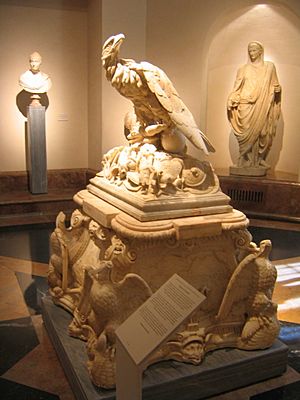The Apotheosis of Claudius facts for kids
The sculpture called The Apotheosis of Claudius is a special art piece you can find in the Prado Museum in Madrid, Spain. It shows an eagle resting on a pile of weapons. This part was originally a tropaion, which was a monument built by ancient Romans to celebrate a victory in battle. It used to stand on a rectangular base with an urn, but those parts are now missing.
This ancient part of the sculpture was found at the home of Marcus Valerius Messalla Corvinus. He was a Roman general and a politician who also loved art. The sculpture was made a very long time ago, between 27 BC and 14 AD. On the old part of the sculpture, you can see an inscription that says: "IMPERATOR·CAESAR·DIVI·FILIVS·AVGVSTVS". This means "the emperor Caesar Augustus, son of the deified [Julius Caesar]". Augustus was a very powerful Roman emperor.
The sculpture gets its name from a head of Claudius that used to be part of it. Claudius was another Roman emperor. This head was made by a sculptor named Orfeo Boselli. It was added to the sculpture when it was placed on a new, larger base. Cardinal Girolamo Colonna owned the sculpture and gave it to Philip IV of Spain in 1664. The original head of Claudius was lost in a big fire at the Alcázar de Madrid in 1734. A smaller head replaced it, but that one has also been removed.
Contents
What is the Apotheosis of Claudius?
The word "apotheosis" means making someone into a god, or treating them like a god. So, "The Apotheosis of Claudius" means honoring Emperor Claudius as if he were a god. This sculpture is a "group" because it has different parts put together. It helps us understand how important emperors were in ancient Rome.
The Eagle and Its Meaning
The main part of the sculpture you see today is an eagle. In ancient Rome, the eagle was a very important symbol. It represented power, strength, and the Roman Empire itself. The eagle was often shown with Roman legions (armies) and on their flags. Seeing an eagle on a pile of weapons shows victory and military might.
Who Was Augustus?
The inscription on the sculpture mentions Augustus. He was the first Roman emperor and one of the most important leaders in history. He ruled from 27 BC to 14 AD, which is when this sculpture was made. Augustus brought a long period of peace and stability to the Roman Empire, known as the Pax Romana.
The Story of the Claudius Bust
Even though the sculpture is named after Claudius, the original eagle and weapons part is much older. The head of Claudius was added later to make the sculpture more complete. This was a common practice in the past, where different parts of art were combined. The loss of the original bust in the 1734 fire is a sad part of its history.
How the Sculpture Came to Spain
The sculpture traveled a long way to get to Spain. It was originally found in Italy. Cardinal Girolamo Colonna, a very important church leader, owned it. He decided to give this valuable artwork to King Philip IV of Spain in 1664. This shows how art was shared and collected by powerful people across Europe centuries ago.
See also
 In Spanish: Apoteosis de Claudio para niños
In Spanish: Apoteosis de Claudio para niños


